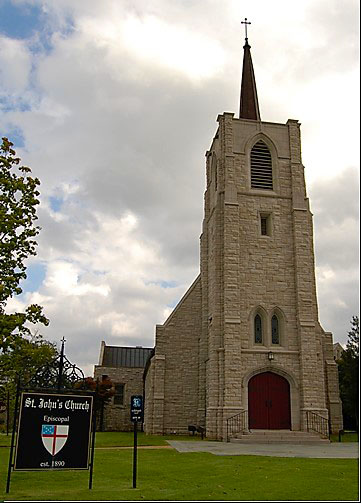
A small group of Episcopalians, who had previously worshiped together in homes, organized St. Paul’s Episcopal Church in 1867. For the next twenty years, both the church and the town prospered.
Members of St. Paul’s Episcopal Church underwent atragedy in 1888 when their beautiful and beloved little church burned to the ground. Naturally, parishioners talked of rebuilding, but resentment began to brew over the location of the next church. Original members wanted St. Paul’s to remain in Old Decatur while newcomers wanted the church rebuilt in New Decatur on land that had been given to St. Paul’s. Finally, the newcomers (approximately 75 in number) withdrew from St. Paul’s in order to begin their own church. St. Paul’s continued until 1930 when it was declared defunct.
The group of newcomers who left St. Paul’s in 1890 immediately began plans for a church of their own. Theirs was a mammoth undertaking. The inflationary bubble had burst, the citizens of Decatur were victims of a crippling economic decline and many businesses were pushed to the brink of bankruptcy. Undaunted, in 1890, this group signed the articles of association to become St. John’s parish.
St. John’s communicants were anxious for a rector and an earnest search began. Efforts were eventually rewarded when, in 1892, Dr. Erastus Wooster Spalding accepted a call issued jointly by St. John’s and St. Paul’s. The two parishes had realized that it was financially necessary to share the rector. Dr. Spalding served for nine years. Achievements during his tenure included the construction in 1893 of the building where St. John’s members still worship. The cost of construction was less than $2,000.
During the past fifty years, the following improvements have been made at St. John’s: limestone veneer added, tower built, sidewalks poured, landscaping planted, pews and air conditioning added, lighting and wiring change, memorial stained glass windows installed, new organ installed (1981), bell hung (1988), chapel built (1988), sacristy enlarged, pews and kneeling stands upholstered, cloistered garden constructed, tower lighted, parish house enlarged for the third time to improve Sunday school, kitchen, office and library facilities, columbarium added and a copper roof was installed on the church building. St. John’s has recently undergone an additional renovation this year.
Through the years, at St. John’s fellowship has always been combined with spiritual growth and hard work. Church records tell of hayrides, picnics, boating, Easter egg hunts, and covered dish suppers.